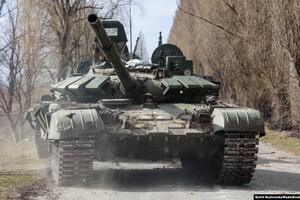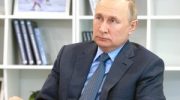As in the days of Soviet intervention in the Vietnam War, arms transfers are not yet part of the battle.

In times of war, a billion euros are spent very quickly. But on April 15, Germany announced that it would allocate just that amount to military aid to Ukraine. And that slightly exacerbated the criticism Berlin faced for refusing to send tanks to the Ukrainian army.
Two days earlier, the United States had promised a new $ 800 million aid package that included infantry armored vehicles and helicopters. The United Kingdom sends armored patrol cars and anti-ship missiles, and the Czech Republic sends MANPADS and T-72 tanks. Slovakia, which has already handed over S-300 air defense systems to Ukraine, has admitted that it can also hand over its MiG-29 aircraft to the Armed Forces, because Ukrainian pilots know how to fly them, The Economist writes.
Back in March, the United States rejected a similar proposal for a MiG-29 from Poland, fearing to “provoke” Russia's reaction and thus draw NATO into the war. French President Emmanuel Macron has openly stated that the transfer of heavy weapons to the Ukrainian army could lead to Russia considering NATO a “cooperating party”, ie a party to the conflict, and therefore a legitimate target under the laws of war. Now the United States says it is not opposed to Slovakia's proposal to transfer aircraft to Ukraine.
Since the beginning of the war, Ukraine's friends have given her only small arms, as well as anti-tank and anti-aircraft missiles. But as suspicions grew that the war would drag on, they became more willing to supply complex systems that would require special training. Russia's war crimes have also convinced allies that heavier equipment should be handed over to Ukraine to liberate Russian-occupied territories. In addition, there is a belief that it is time to move from Soviet-style to modern NATO weapons, which will be easier to maintain and supply.
Read also: Zelensky on the unblocking of Mariupol: “Either partners will give Ukraine weapons, or – negotiations”
However, the shift towards heavier weapons has sparked alarm in some circles, especially in Germany. Berlin blocked the transfer of Marder armored vehicles after the German Ministry of Defense complained that such equipment was too little even for the German army. MP from the “Left” Sarah Wagenknecht said that before the delivery of Marder will make Germany a “participant in the war.” Even Vice Chancellor Robert Habeck, who took a rather tough stance, said his country “should not be the target itself”. All these comments seem to be directly related to the fear that the supply of heavy weapons will provoke a direct conflict between Russia and NATO.
But from a historical point of view, such concerns are unfounded. For example, consider the MiG-29 aircraft. During the Vietnam War, dozens of American planes were shot down by fighters north of the Soviet Union. In addition, North Vietnam received a large number of tanks, missiles, and artillery systems from its patrons in the Kremlin and Beijing. And all these weapons were used to kill thousands of American soldiers. Both sides feared that indirect warfare could escalate into direct conflict between nuclear powers. But that didn't happen.
The war in Ukraine is a similar situation. Unless the roles of the parties are now opposite. This time, Russia is waging war against a local neighbor whose army has been armed and trained by the United States and its allies. Russia has threatened NATO that it could strike at countries that supply or assist Ukraine's army. She even hinted at the use of nuclear weapons. From the point of view of international law, experts say, Russia's position is unjustified.
“The supply of weapons, including heavy weapons, does not make any third country a party to an armed conflict. This requires more direct involvement in military operations, “said Adil Hayk, a professor at the Rutger School of Law.
But this was not always the case. International law, which began to develop in Europe in the early 17th century, required countries to adhere to strict neutrality if they did not want to get involved in other people's wars. This meant that they had to continue to trade with both sides of the conflict. Therefore, the supply of weapons to only one of the parties meant a violation of neutrality. However, this rule was developed for a world in which war was considered an acceptable tool of public administration. That all changed after the Brian Kellogg Pact was passed in 1928, which banned unprovoked attacks by some countries against others. This principle was later included in the UN Charter.
The charter recognizes the right of countries to self-defense. In addition, other countries can join the “collective self-defense”. States are allowed to provide weapons to victims of aggression or impose sanctions on the aggressor. And this will not affect their neutral status. When the UN Security Council condemns aggression, the resolution is legally binding on all member states. In the case of Ukraine, such a resolution has not yet been approved, but only because Russia, as a permanent member, has vetoed such decisions each time. The UN General Assembly has strongly condemned Russia's attack on Ukraine.
Read also: Ukraine needs weapons to expel the occupiers from our land – Zelensky in the Dutch parliament
As for the role of the “warring party”, the bar is even higher, – says Michael Schmitt of the US Military Academy at West Point. The supply of German weapons to Ukraine will not make Germany a party to the war with Russia, because “there is no enmity between these countries”, ie their soldiers do not kill each other. Analysts emphasize that all definitions of neutrality and complicity in the war do not matter at all. If Vladimir Putin decides not to attack NATO convoys with weapons for Ukraine, it is not because of the convincing force of international jurisprudence. It is equally naive to think that supplying only small arms (which ultimately kills Russian soldiers) will force Putin to be more restrained.
“If Russia wants to feel 'provoked' and attack NATO, it will do so regardless of whether tanks are supplied or not,” said Claudia Major, an expert at the German Institute for International Affairs and Security.
At the same time, the legal aspects of participation and neutrality should not be ruled out altogether. After all, they can help prevent the escalation of the conflict before nuclear war. When the United States and other NATO nations rejected the idea of sending troops to Ukraine, they stressed that it would make them parties to the conflict. According to Hayek, this is a useful way to draw a “red line” between nuclear powers.
“The United States is using these rules of international law to let Russia know that it is ready to approach that red line but not cross it. I think Moscow understands this. But it is trying to question the American interpretation of these rules and draw its own red line, not based on rules that would serve Russia's purposes, “the expert explained.
The Red Line game also took place in Vietnam. The scale of Soviet and Chinese supplies of heavy weapons to North Vietnam overshadows all that Ukraine has received. After the split between the USSR and China in 1964, the two communist states competed with each other in arms supplies. By the end of the war in 1975, they had sent up to 500 aircraft (including 180 fighters), 2,500 tanks and tens of thousands of artillery systems to North Vietnam. Soviet soldiers often operated air defense systems that shot down American planes over Hanoi. Russian historical propaganda still boasts of this, even at a time when Russia is angrily complaining about Western arms supplies to Ukraine.
Read also: NYT: Ukraine can be armed at Russia's expense
However, the United States has never accused the Soviet Union or China of being complicit. And the nuclear powers did not come close to direct conflict. American bombers avoided Soviet fighters. When US Air Force pilots accidentally shot down a Soviet plane in 1967, they were tried. At that time, America was guided not by international law, but by the fact that the involvement of the USSR or China in the war was not in its interests.
For Russia today, this logic will also be a determining factor in the war against Ukraine.
< "If Russia wanted to expand the conflict and involve us, it would have done so successfully. They want to scare us, not get into a direct fight. Russia cannot cope with Ukraine, let alone NATO, "said Kalev Stoitcescu, an expert at the Tallinn Center for Defense and Security.
See the special topic: Every third Ukrainian thinks that it is wrong to leave home and relatives now – poll Also, respondents do not want to leave loved ones. Azov told why the Russians managed to surround Mariupol Before the war, it was clear that the city “would be one of the main outposts on the front line, but was not planned that he will be surrounded “. The Lviv OVA commented on the condition of the victims of the missile strike 11 people were hospitalized, including a 3-year-old boy. Russia has concentrated at least 36 cruise missiles in the Black Sea Rashists are preparing to attack in eastern Ukraine. Gaidai explained why the Armed Forces withdrew from Kreminna If our military remained in the previous positions, they would lose a large number of personnel. They need to regroup.




